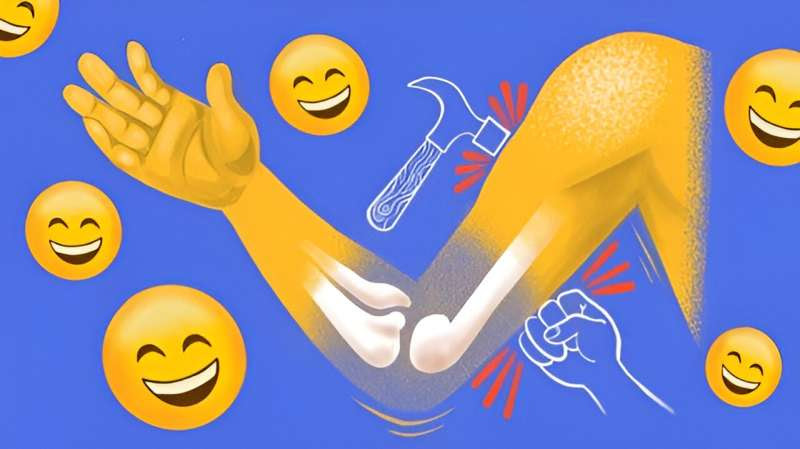by Valerie Goodwin, University of Michigan

Credit: Justine Ross, Michigan Medicine
Everyone knows hitting your funny bone isn’t actually funny. But what happens when that feeling continues to persist?
In this interview, Sandra Hearn, M.D., a clinical associate professor of physical medicine and rehabilitation at the University of Michigan and the lead author of an editorial on ulnar neuropathy published in Muscle & Nerve, breaks down what ulnar neuropathy is and how electrodiagnostic studies can assess severity and guide management, which can sometimes include conservative treatment and education on how to protect the nerve.
What is ulnar neuropathy?
The ulnar nerve is the nerve that is commonly referred to as the funny bone. In patients with ulnar neuropathy, the fibers in this nerve can become damaged.
The ulnar nerve is vulnerable to getting entrapped or compressed right around that spot near the elbow that most people are familiar with.
The electrical signal traversing the nerve can become slowed down or blocked due to a compression of the nerve. If the compression persists, nerve fibers can die away leading to persistent numbness, pain or weakness.
What are some symptoms of ulnar neuropathy?
People with ulnar neuropathy, or compression of the nerve at that spot near the elbow, can experience numbness and tingling to the pinky side of the hand, and weakness of hand muscles.
The weakening of the hand that comes with ulnar neuropathy can make doing daily tasks that require motor skills difficult and may eventually cause permanent shrinkage or loss of the muscles in the hand altogether if left untreated.
It’s like the hand loses power.
What does treatment of ulnar neuropathy look like?
For people experiencing weakness because of a compressed nerve, what kind of recovery to expect depends on the type of nerve damage.
Sometimes the nerve fibers die away. If enough fibers are affected, it can be hard to make a full recovery, regardless of surgical or conservative treatments.
But other times, they are experiencing a conduction block where the nerve fibers, also called axons, are still alive but failing to transmit its signal. In this situation, patients can experience significant weakness and numbness, even though the underlying axons are intact.
But for this group of patients, if the nerve is protected enough to wake up again, a complete recovery process can happen.
Even among nerves with conduction block, the type of block and the time needed to recover likely depends on different factors such as which nerve is affected, how long the nerve has been compressed and how fully the compressive factor can be alleviated.
Research is giving a better understanding of how long it takes for the ulnar nerve to recover when it has been compressed for an extended period and has experienced a conduction block.
How do you recover from ulnar neuropathy?
Ulnar neuropathy patients with conduction block were able to make a complete recovery with time and activity adjustment, such as avoiding leaning on the forearm in ways that compress the nerve and avoiding resting with the elbow bent for prolonged periods of time.
The recovery process can take about eight months from symptom onset and six months from the start of conservative management, but a complete recovery without surgery is possible for this group of patients.
This gives a positive outlook for ulnar neuropathy patients with this type of nerve damage and underscores the important role of electrodiagnostic testing in identifying them.
How do you determine if your nerve fibers are still intact?
Doctors can gauge the severity of the ulnar neuropathy.
This can include electrodiagnostic testing, nerve condition studies and electromyography, also known as EMG, to assess nerve function and viability.
The electrodiagnostic study can assess to what degree the weakness is due to conduction block versus actual nerve fiber loss. This information can guide appropriate monitoring and treatment.
Hopefully, future research will help bring understanding to the process by which the different nerves and injury types recover, and how treatments can impact that time to recovery.
How do you know if conservative management or surgery is right to treat your ulnar neuropathy?
Having a conversation with your doctor before starting any treatment is crucial. Talk though all the options you need to look at nerve activity and address the situation at hand.
You can also discuss with your doctor ways to protect the nerve and prevent the condition from worsening.
Treatment will look different for each case, but it is important to have an open and honest discussion with your doctor before moving on to any treatment.
More information: Sandra L. Hearn et al, Unblocking the ulnar nerve: It takes time, Muscle & Nerve (2023). DOI: 10.1002/mus.27958
Provided by University of Michigan

Leave a Reply